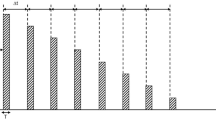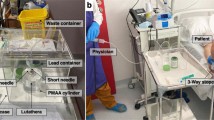Abstract
Purpose
The widespread interest in 90Y internal radionuclide treatments has drawn attention to the issue of radiation protection for staff. Our aim in this study was to identify personnel at risk and to validate the protection devices used.
Methods
90Y-MoAb (Zevalin, 15 cases, 1.1 GBq/patient) and 90Y-peptide (90Y-DOTATOC) systemic (i.v., 50 cases, 3.0 GBq/patient) and locoregional (l.r., 50 cases, 0.4 GBq/patient) treatments were considered. Radiolabelling was carried out in a dedicated hot cell. Tele-tongs, shielded (PMMA: polymethylmethacrylate) syringes/vials and an automatic dose fractionating system were used. Operators wore anti-X-ray and anti-contamination gloves, with TLD dosimeters placed over the fingertips. For i.v. administration, activity was administered by a dedicated system; for l.r. administration, during activity infusion in the brain cavity, tongs were used and TLDs were placed over the fingertips. The air kerma-rate was measured around the patients.
Results
The use of devices provided a 75% dose reduction, with mean fingertip doses of 2.9 mGy (i.v. MoAbs), 0.6 mGy (i.v. peptides)/radiolabelling procedure and 0.5 mGy/l.r. administration. The mean effective dose to personnel was 5 μSv/patient. The air kerma-rate around the patients administered i.v. 90Y-peptides were 3.5 (1 h) and 1.0 (48 h) μGy/h at 1 m. Patient hospitalisation of 6 h (l.r.)/48 h (i.v.) guaranteed that the recommended limits of 3 mSv/year to family members and 0.3 mSv/year to the general population (Council Directive 97/43/Euratom) were respected.
Conclusions
When specific procedures are adopted, a substantial improvement in 90Y manipulation is attainable, reducing doses and increasing safety. For the widespread clinical use of 90Y-conjugates, a completely automatic labelling procedure is desirable.





Similar content being viewed by others
References
Delacroix D, Guerre JP, Leblanc P, Hickman C. Radionuclide and radiation protection data handbook 2002, 2nd edition. Rad Prot Dos 2002;98:1–168
Bodei L, Cremonesi M, Grana C, Rocca P, Bartolomei M, Chinol M, et al. Receptor radionuclide therapy with 90Y-[DOTA]0-Tyr3-octreotide (90Y-DOTATOC) in neuroendocrine tumours. Eur J Nucl Med Mol Imaging 2004;31:1038–1046
Schumacher T, Hofer S, Eichhorn K, Wasner M, Zimmerer S, Freitag P, et al. Local injection of the 90Y-labelled peptidic vector DOTATOC to control gliomas of WHO grades II and III: an extended pilot study. Eur J Nucl Med Mol Imaging 2002;29:486–493
Paganelli G, Grana C, Chinol M, Cremonesi M, De Cicco C, De Braud F, et al. Antibody-guided three-step therapy for high grade glioma with yttrium-90 biotin. Eur J Nucl Med Mol Imaging 1999;26:348–357
Witzig TE, Flinn IW, Gordon LI, Emmanouilides C, Czuczman MS, Saleh MN, et al. Treatment with ibritumomab tiuxetan radioimmunotherapy in patients with rituximab-refractory follicular non-Hodgkin’s lymphoma. J Clin Oncol 2002;20:3262–3269
Wagner HN, Wiseman GA, Marcus CS, Nabi HA, Nagle CE, Fink-Bennett DM, et al. Administration guidelines for radioimmunotherapy of non-Hodgkin’s lymphoma with 90Y-labeled anti-CD20 monoclonal antibody. J Nucl Med 2002;43:267–272
Tosi G. Report on one accident occurred in a nuclear medicine department in Italy. In: Proceedings of the 6th European ALARA Network workshop. Occupational Exposure Optimisation in the Medical Field and Radiopharmaceutical Industry. Sponsored by the European Commission Radiation protection. Madrid; 2002;225
Salako QA, DeNardo SJ. Radioassay of yttrium-90 radiation using the radionuclide dose calibrator. J Nucl Med 1997;38:723–726
Siegel JA, Zimmerman BE, Kodimer K, Dell MA, Simon WE. Accurate dose calibrator activity measurement of 90Y-ibritumomab tiuxetan. J Nucl Med 2004;45:450–454
Zimmerman BE, Cessna JT. Experimental determinations of commercial ‘dose calibrator’ settings for nuclides used in nuclear medicine. Appl Radiat Isot 2000;52:615–619
Council Directive 97/43/Euratom 1997 on health protection of individuals against the dangers of ionising radiation in relation to medical exposure. Available on http://europa.eu.int/comm/energy/nuclear/ radioprotection/doc/legislation/9743_en.pdf
Actuation of the Council Directive 97/43/Euratom 1997 in the Italian regulation (Decreto Legislativo 26 maggio 2000, n. 187. Attuazione della direttiva 97/43/EURATOM in materia di protezione sanitaria delle persone contro i pericoli delle radiazioni ionizzanti connesse ad esposizioni mediche). Available on http://www.camera.it/ parlam/leggi/deleghe/testi/00187dl.htm
Zanzonico PB, Binkert BL, Goldsmith SJ. Bremsstrahlung radiation exposure from pure beta-ray emitters. J Nucl Med 1999;40:1024–1028
Aubert B, Guilabert N, Lamon A, Ricard M. Which protection against radiation for new protocols of internal radiotherapy by 90Y. In: Proceedings of the 6th European ALARA Network workshop. Occupational Exposure Optimisation in the Medical Field and Radiopharmaceutical Industry. Sponsored by the European Commission Radiation protection. Madrid 2002;47–49
Sarfaraz M, Kennedy AS, Cao ZJ, Sackett GD, Yu CX, Lodge MA, et al. Physical aspects of yttrium-90 microsphere therapy for nonresectable hepatic tumors. Med Phys 2003;30:199–203
Stabin M, Siegel J, Lipsztein J, Hunt J, Brill A, Sparks R, et al. RADAR (RAdiation Dose Assessment Resource). http://www.doseinfo-radar.com; http://www.ieo.it/radar
Saether HK, Davidson TM, Widmark A, Wohni T. Measurements of finger doses in x-ray guided surgery, nuclear medicine and research. Radiat Prot Dosimetry 2005;113:392–395
Cremonesi M, Ferrari M, Sacco E, Rossi A, Leonardi L, Chinol M, et al. Radiation protection in radioguided surgery of breast cancer. Nucl Med Commun 1999;20:919–925
Release of patients after therapy with unsealed radionuclides. International Commission on Radiological Protection, ICRP Publication 94, 2005. http://www.elsevier.com
Acknowledgement
The authors are especially grateful to William Russell Edu for English revision.
Author information
Authors and Affiliations
Corresponding author
Rights and permissions
About this article
Cite this article
Cremonesi, M., Ferrari, M., Paganelli, G. et al. Radiation protection in radionuclide therapies with 90Y-conjugates: risks and safety. Eur J Nucl Med Mol Imaging 33, 1321–1327 (2006). https://doi.org/10.1007/s00259-006-0151-1
Received:
Revised:
Accepted:
Published:
Issue Date:
DOI: https://doi.org/10.1007/s00259-006-0151-1




